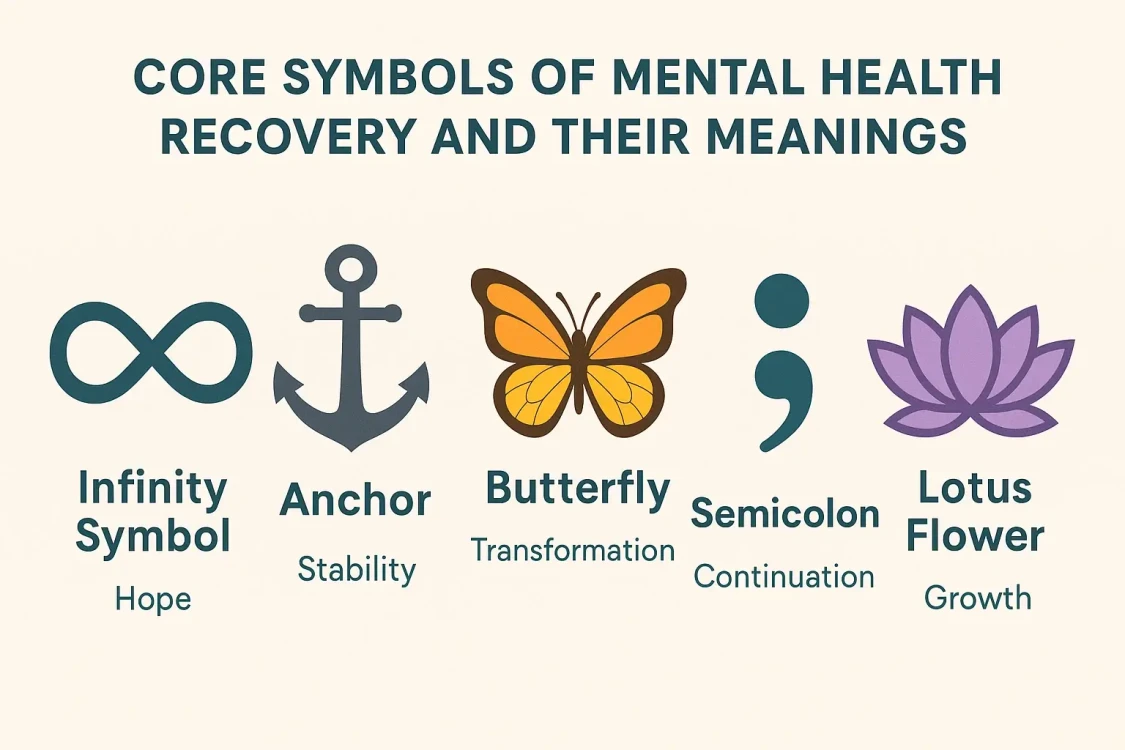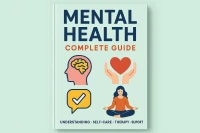Mental health recovery symbols hold great power. They can heal, inspire, and connect those on similar journeys. People have used visual symbols for centuries. These symbols help express complex emotions and experiences. Sometimes, feelings are too hard to describe in words.
Why Humans Connect with Recovery Symbols
Humans use symbols for healing and recovery because we need understanding and a sense of connection. Feeling depression, anxiety, trauma, or other mental health issues can be very lonely. A symbol of hope, strength, or survival shows you that many have faced and overcome similar challenges.
Symbols work because they communicate without delay. You may spot someone with a semicolon tattoo. This tattoo shows they've faced tough times. They thought about ending their life, but they chose to continue their story. No words are needed, but a powerful connection forms.
Creating Awareness and Reducing Stigma
Symbols create awareness, reduce stigma, and inspire hope in key ways. Wearing symbols of mental health recovery, like jewelry, tattoos, or clothing, helps break the silence. Sharing these symbols on social media also raises awareness about mental health struggles. This openness helps us discuss depression, anxiety, and other hidden issues more easily.
Mental health awareness colors and symbols also create recognition and unity within communities. Mental health symbols raise awareness, just like pink ribbons for breast cancer. They help people find resources, support groups, and others who share their experiences. This recognition can be life-saving for someone feeling totally alone in their struggle.
Mental health symbols mean more than just personal healing. They also help build community and drive social change. When many people adopt and share these symbols, they become powerful tools for advocacy. This helps improve mental health services and lowers discrimination.
Colors and Their Role in Recovery Awareness
Colors play a crucial psychological role in how we process emotions and healing. Colors hold symbolic meanings in the context of mental health recovery. This helps us understand why certain colors are associated with specific movements and causes.
Green as the Universal Mental Health Color
Green as the universal color for mental health didn't happen by accident. This color stands for growth, renewal, balance, and hope. These are key parts of mental health recovery. Green in nature evokes images of new leaves, grass sprouting after winter, and the fresh start of spring.
The green ribbon mental health recovery movement has experienced significant growth over the last decade. During Mental Health Awareness Month in May, you'll see green ribbons. Advocates wear them, and organizations worldwide use them to support mental health initiatives. This consistent use of green helps create instant recognition and a sense of solidarity.
Emotional Impact of Different Colors
Colors can express emotions such as calm, renewal, and balance. This idea is closely linked to research in color psychology. Blue represents peace and calm. That's why some mental health groups use blue in their awareness campaigns. Purple symbolizes transformation and spiritual healing. Yellow represents hope and positivity.
Color associations help explain why certain combinations function as symbols for mental health recovery. Mixing green and blue in a recovery symbol brings together calm and growth.
Specific Mental Health Color Movements
Other awareness colors tied to mental health movements include:
- Teal for PTSD awareness
- Silver for brain disorders
- Lime green for lymphoma survivors facing mental health challenges from their illness.
Each color movement has built its own community and support network. This shows how strong color symbolism can be in uniting people.
Core Symbols of Mental Health Recovery and Their Meanings

The most popular symbols of mental health recovery come from communities. They aim to share experiences and connect with others. These symbols are widely known. They represent universal parts of the healing journey.
Semicolon: Choosing to Continue
A semicolon stands for choosing to continue rather than end. It has become a well-known symbol in the field of mental health recovery. Amy Bleuel created the semicolon symbol for mental health. She started Project Semicolon in 2013 to honor her father, who died by suicide.
The power of this symbol lies in its grammatical meaning. In writing, you use a semicolon when you could end a sentence but choose to continue instead. For those who have had suicidal thoughts, the semicolon stands for the choice of life over death. It symbolizes continuation instead of an ending.
Mental health tattoo symbols often feature the semicolon. It's small and straightforward, yet it holds deep personal meaning. Many people choose semicolon tattoos that they can see every day. These tattoos remind them of their strength and their choice to keep living.
Lotus Flower: Rising Above Struggles
The Lotus Flower represents overcoming challenges and personal growth. This symbolism comes from thousands of years of spiritual and cultural tradition. The lotus flower is a symbol of mental health recovery. It resonates with many because of its growth. Lotus flowers begin in muddy, dark water at the pond's bottom. Then, they rise through the darkness to bloom beautifully on the surface.
This natural process mirrors the mental health recovery journey perfectly. You might start in a very dark place, feeling stuck in depression, anxiety, or trauma. Like the lotus, you can rise from darkness and bloom into something beautiful and strong.
Cultural symbols for mental health recovery often include the lotus. It symbolizes spiritual awakening. It also represents overcoming suffering in Hindu, Buddhist, and other Eastern traditions. This cross-cultural recognition makes it particularly meaningful for people from diverse backgrounds.
Butterfly: Transformation and New Life
The butterfly symbolizes transformation and new life. It's ideal for those who have gone through significant mental health recovery. The butterfly is a symbol of mental health. It represents healing, which often includes significant life changes and personal growth.
The symbolism comes from the butterfly's life cycle. It begins as a caterpillar. Then, it enters a dark cocoon. Finally, it emerges completely transformed. Mental health recovery involves tough therapy, adjusting medications, or making significant life changes. Through this, a person can become stronger and healthier.
Symbols of change, such as the butterfly, demonstrate that recovery from mental health issues is possible. Even when it feels hard, it can happen. Many people like butterfly imagery for tattoos, jewelry, or art. It symbolizes their journey from illness to wellness.
Anchor: Stability During Difficult Times
An anchor represents stability in times of turmoil. It offers grounding when chaos surrounds us. The anchor symbol supports mental health recovery. It aids people dealing with depression, anxiety, or other issues. It serves as a reminder to stay steady during tough times.
Anchors keep ships steady in rough seas. This is what people need during mental health crises. Your anchor could be your family, therapy sessions, medication, spiritual practice, or your commitment to recovery. The symbol reminds you that you have something solid to hold onto.
This symbol is great for anyone whose thoughts or feelings often shift or feel too much. The anchor symbolizes the steady parts of life. These can offer stability during healing.
Infinity Symbol: Endless Strength and Recovery
The Infinity Symbol stands for endless strength and continuous recovery. It shows that mental health recovery is a lifelong journey, not just a goal. The infinity symbol for healing shows that strength and recovery are limitless. This reminds people they can heal, even when they feel weak.
This symbol is great for those who know recovery isn't a straight path. There will be good days and bad days, as well as progress and setbacks. Still, the journey goes on forever. It shows that no matter how tough things become, there's always hope for healing and growth.
Many people mix the infinity symbol with other recovery symbols. This creates unique designs that reflect their personal healing journeys. The versatility of this symbol makes it adaptable to many different recovery stories.
Modern & Emerging Mental Health Recovery Icons
As mental health awareness grows, new symbols appear. These symbols represent different parts of mental health advocacy and recovery. These modern symbols often combine traditional meanings with today's mental health issues.
Mental Health Bell: Breaking Stigma
Mental Health Bell symbolizes breaking the stigma around mental health. It aims to bring these issues into the open. The mental health bell symbolizes breaking the chains that held people in asylums.
Mental Health America adopted this potent symbol. It stands for the fight against discrimination and celebrates recovery. The bell symbol stands for freedom. It ends the shame and secrecy around mental health struggles that have lasted for ages.
The bell symbolizes hope. It also calls for better mental health services and understanding. It demonstrates to communities that mental health recovery is achievable. Society should support those seeking help, rather than stigmatizing them.
The Blue Dot: Maternal Mental Health Support
The Blue Dot focuses on maternal and perinatal mental health. It addresses the special challenges mothers face with postpartum depression, anxiety, and other perinatal issues. The blue dot symbol for mental health awareness is gaining recognition. Healthcare providers and support groups focused on maternal mental health are embracing it.
This symbol is crucial because maternal mental health is often ignored or downplayed. The blue dot helps mothers in need. It helps healthcare providers spot patients who need extra mental health support during pregnancy and after childbirth.
Creative Symbol Combinations
Creative combinations of existing symbols show how people personalize their recovery representations. You might see designs that mix a semicolon with a butterfly. This illustrates the decision to continue living and the transformation that follows. Some people make infinity symbols using semicolons. This combines the concept of ongoing recovery with the decision to persevere.
New mental health recovery icons now include fresh takes on traditional symbols for digital use. Social media lets people share creative designs for mental health awareness. These designs are easily recognizable online, allowing them to reach a larger audience.
These creative combinations help people share their unique stories. They also connect with larger mental health movements. Personal recovery symbols in mental health can change and grow with individual experiences. Yet, they still keep a universal meaning.
Personalizing Recovery Symbols
Select mental health recovery symbols that align with your story, values, and healing journey. Personal symbols become powerful tools for daily motivation and long-term recovery support.
Tattoos and Body Art as Recovery Expression
Tattoos, jewelry, artwork, and clothing express identity and mark recovery milestones for many. Mental health tattoo symbols and their meanings vary from individual to individual. Still, they all aim to make recovery visible and lasting.
Unique mental health recovery tattoo ideas often combine universal symbols with personal elements, creating a distinctive and meaningful design that is both universal and personal. A person might get a lotus flower tattoo. They could add dates for important recovery milestones. They could also add a semicolon to a special quote or image. These personalized designs create symbols that are both globally recognizable and deeply personal.
The permanence of tattoos can be particularly meaningful for people in recovery. A recovery symbol on your body is a constant reminder of your strength. It reflects your journey and shows your commitment to healing.
Daily Reminders and Motivational Tools
Symbols can remind us of our strength and resilience. They help keep us focused on recovery goals, whether the days are good or tough. You can wear jewelry with recovery symbols. You might display artwork at home. Also, you can carry small tokens in your pocket or purse.
Select symbols that genuinely represent your experiences. Place them where you'll notice them often. Some people put recovery symbols on phone cases. Others wear them as necklaces. Some keep them on their desks as a reminder during stressful days.
Digital and Social Media Movements
Social media hashtags and digital movements raise awareness. They create fresh ways to share and connect through recovery symbols. Hashtags like #ProjectSemicolon and #MentalHealthAwareness help people connect with communities online. They make it easier to find support. Specific symbol hashtags also play a role in this.
Digital platforms let people share recovery symbols through photos, stories, and posts. This builds virtual communities based on shared experiences. This online visibility normalizes mental health struggles and recovery. It also inspires and supports others facing similar challenges.
Digital recovery symbols are easier for those not ready for permanent tattoos. They help people connect with recovery communities and support mental health awareness.
Cultural & Spiritual Dimensions of Healing Symbols
Different cultures and spiritual traditions see recovery symbols in unique ways. Knowing these views helps people pick symbols that reflect their heritage, beliefs, and values. Cultural connections can make symbols more meaningful. They enhance personal healing journeys.
Eastern and Western Symbol Traditions
Different cultures see recovery through symbols in unique ways. This depends on their religious traditions, historical experiences, and cultural values. Mental health symbols vary across cultures. They often come from long-standing spiritual and healing traditions. These practices have been essential in their communities for centuries.
Eastern traditions often utilize spiritual symbols to promote mental health. The lotus flower represents rising above suffering. The endless knot symbolizes interconnectedness and the ongoing nature of healing. These symbols hold strong spiritual meaning. They go beyond just mental health and connect to overall spiritual wellness.
Western traditions often emphasize symbols of strength, personal resilience, and overcoming challenges. The anchor, infinity symbol, and semicolon show Western values. They emphasize personal choice, individual strength, and the capacity to alter one's circumstances.
Spiritual and Religious Connections
Spirituality and cultural heritage play a key role in choosing symbols. They link recovery to deeper life goals and beliefs. People who have firm religious or spiritual beliefs often choose recovery symbols that reflect their faith. This choice helps link mental health healing with spiritual growth.
You can add prayer symbols, religious images, or spiritual ideas to your recovery symbols. Combining mental health recovery with spiritual meaning can boost motivation and support healing.
Global Recognition vs. Personal Meaning
Balancing global mental health icons with personal cultural ties helps people connect to larger mental health movements. It also honors their unique heritage and beliefs. This balance helps create symbols that are both personally meaningful and widely understood.
Some people use widely recognized symbols, like the semicolon, in public. They keep culturally specific healing symbols for private or community use. Some people mix global recovery symbols with cultural elements. This creates unique representations of their multicultural healing experiences.
How to Choose the Right Symbol for Your Journey
Choosing a meaningful recovery symbol takes thought. Think about your story. What are your recovery goals? Also, how does this symbol relate to your future? The right symbol should connect with your experience. It should also inspire and support you over time.
Personal Meaning vs. Global Recognition
When choosing between personal meaning and global recognition, think about how you'll use the symbol. Also, consider the connections you want to make with others. Symbols of hope and mental health strength are well-known. They can help you connect with larger recovery communities and advocacy movements.
Deeply personal symbols may not be obvious to everyone. Still, they can offer intimate meaning and strengthen your healing journey. The best choice often depends on your goals. Do you want the symbol mainly for personal motivation? Or do you also want it for community connection and advocacy?
Long-term Emotional Connection
Emotional connections and lasting relevance are key, especially for permanent choices like tattoos. Mental health symbols for resilience and growth should remain vital as you heal and your life evolves.
Consider whether the symbol will still hold meaning for you in five or ten years. Does it reflect your ongoing healing, not just how you feel at this moment? Symbols representing recovery processes, rather than specific moments, remain relevant for an extended period.
Creative Personal Combinations
Mixing your creativity with universal symbols allows you to create icons that benefit both you and your community. Combining symbols for mental health tattoos creates unique and visually appealing designs. These tattoos share your personal story and link to larger movements.
The most effective symbols for mental health recovery incorporate elements that represent various stages of the healing process. This can include symbols that represent challenges, support systems that helped, or spiritual beliefs that provide strength and support.
Choosing a mental health recovery symbol is all about finding something that inspires you. It should reflect your values, beliefs, and recovery goals.
Conclusion
Mental health recovery symbols are powerful. They help us show, remember, and celebrate the healing journey that many people go through every day. Choose from the famous semicolon, the strong butterfly, the reliable anchor, or create your own symbols. These signs connect personal stories to community support.
The healing symbols listed here help you connect with your recovery story. They also support larger mental health awareness efforts. Ancient symbols, such as the lotus flower, and modern ones, like the mental health bell, inspire hope. They remind you of your strength.
At Gendrics, we understand that recovery is a personal journey. It's also part of a bigger journey of healing and growth. The symbols you pick for your mental health journey are part of your story. They remind you during tough times and celebrations.
The best recovery symbol is one that genuinely reflects your experience. It should inspire you as your healing journey continues. These symbols show the strength needed to prioritize mental health. They can be used publicly for advocacy or kept private for personal motivation. Either way, they remind us of the importance of ongoing wellness.




Comments